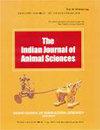不同地板条件下奶牛蹄、腿损伤发生率分析
IF 0.3
4区 农林科学
Q4 AGRICULTURE, DAIRY & ANIMAL SCIENCE
引用次数: 0
摘要
本研究探讨了不同地板对杂交奶牛蹄健康和腿损伤的影响。实验动物(n=24),随机分为四组,分别为:T0(混凝土+砖铺设)、T1(混凝土+砂)、T2(橡胶垫+砂)和T3(橡胶垫+砖铺设)。在研究期间,按照标准方案记录足部和肢体损伤评分。白线病变评分组间差异不显著,但单侧病变评分和指间间隙病变评分组间差异显著。T0组足底和指间间隙病变评分均较高。蹄总病变评分组间差异较大,T0组评分最高。在治疗的第5和第6个月,月均蹄损伤评分有显著差异。从第5个月开始,T1和T2呈下降趋势。相比之下,T0表现出蹄损伤评分升高。两组间膝关节损伤评分及飞节损伤评分差异显著。T0组奶牛得分较高,T1组得分较低。第4个月后,T1和T2组膝关节病变评分下降,而T0和T3组无变化。类似的趋势也见于飞节损伤评分。综上所述,在散舍空旷区设置沙床地板,在遮蔽区设置橡胶垫地板或不设置橡胶垫地板,在减少蹄部和肢体损伤方面,均能较好地改善动物福利。本文章由计算机程序翻译,如有差异,请以英文原文为准。
Incidence of hoof and leg injuries in dairy cow under different floor
Present study explored the effect of different floor on hoof health and leg injuries of crossbred dairy cow. Animals (n=24), were randomly assigned into four groups with different floor combination in covered and open area, viz. T0 (concrete and brick paved), T1 (concrete and sand), T2 (rubber mat and sand) and T3 (rubber mat and brick paved). Hoof and limb lesion scores were recorded as per the standard protocol during study period. White line lesion score did not differ significantly, however, sole lesion score and inter-digital space lesion score differed significantly between the groups. Both, sole and interdigital space lesion scores were greater in T0 group. Total hoof lesion score was different between the groups with highest value in T0 group. Month wise hoof lesion scores differedsignificantly in 5th and 6th month between treatments. Decreasing trend was noticed in T1 and T2 from 5th month onwards. In contrast, T0 showed increase in hoof lesion score. Knee lesion score and hock lesion score were different between treatments. Higher scores were found in cows housed in T0 group, while lower scores were noted in T1 group. Knee lesion score decreased in T1 and T2 groups 4th month onwards, however no change was seen in T0 and T3 group. Similar trend was also seen for hock lesion score. In conclusion, provision of sand bed floor in open area of loose house with or without rubber mat floor in covered area was found superior for improving animal welfare in terms of lesser hoof and limb injuries.
求助全文
通过发布文献求助,成功后即可免费获取论文全文。
去求助
来源期刊

Indian Journal of Animal Sciences
农林科学-奶制品与动物科学
CiteScore
0.60
自引率
25.00%
发文量
220
审稿时长
8 months
期刊介绍:
Articles published in The Indian Journal of Animal Sciences encompass a broad range of research topics in animal health and production related to cattle, buffalo, sheep, goat, camel, equines, pig, rabbit, yak, mithun, poultry and fisheries. Studies involving wildlife species and laboratory animal species that address fundamental questions about their biology will also be considered for publication. All manuscripts must present some new development and must be original, timely, significant and scientifically excellent. Papers will be rejected if standards of care of, or procedures performed on animals are not up to those expected of humane veterinary scientists. At a minimum, standards must meet the International Guiding Principles for Biomedical Research involving Animals, as issued by the Council for International Organizations of Medical Sciences. (C.I.O.M.S., c/o WHO, CH 1211 Geneva 27, Switzerland). Articles reporting new animal disease must follow GOI directive as given in detail in Guidelines to Authors.
 求助内容:
求助内容: 应助结果提醒方式:
应助结果提醒方式:


